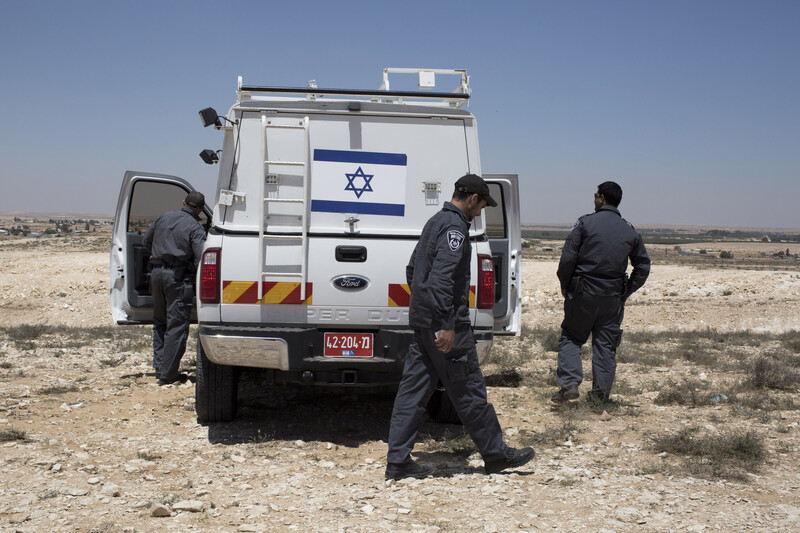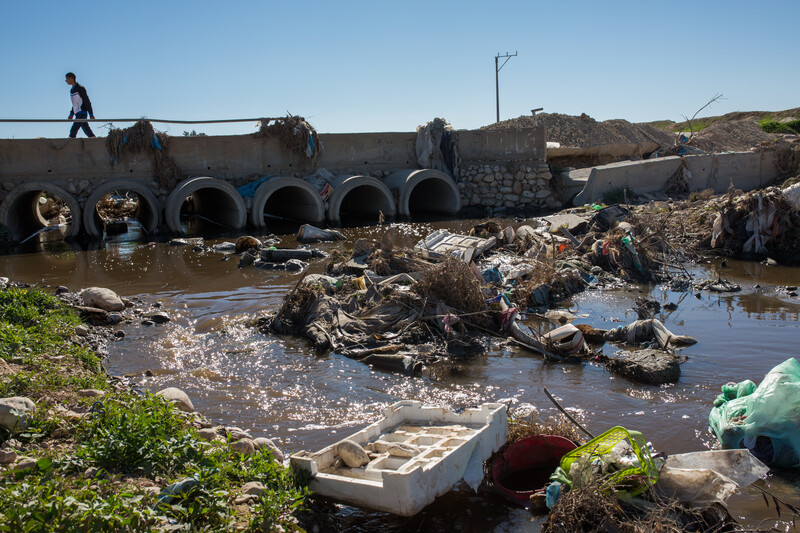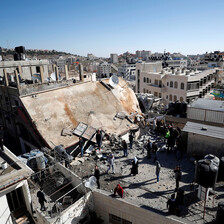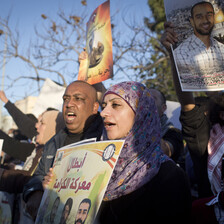The Electronic Intifada 28 October 2016

A home in Bir Hadaj hit with a demolition order in April 2014.
ActiveStillsThe area around Bir Hadaj provides a stark illustration of how Israel runs an apartheid system.
Located in the Naqab (Negev in Hebrew) region of present-day Israel, Bir Hadaj hosts an agricultural community of around 7,000 Palestinian Bedouins. They are crammed into 6,500 dunams (a dunam is the equivalent of 1,000 square meters).
By contrast, approximately 1,000 Jews live in the neighboring kibbutz of Revivim. It covers an area of 30,000 dunams, one-sixth of which is reserved for olive trees.
Unlike the residents of Revivim, the Bedouins of Bir Hadaj have been repeatedly attacked by the Israeli authorities.
On 9 October, Israel sent its feared bulldozers into the village, accompanied by a large contingent from the state’s militarized police force.
Seven homes in which members of the Abu Mreihil family lived were demolished, along with three homes that were under construction. At least 36 people, including a week-old baby, were deprived of shelter.
Salameh Abu Mreihil, the mother of the baby, said that she will never forget how she became homeless so soon after giving birth. “This is the fate of our people here,” she said. “They have to suffer from the moment they are born.”
Her family is now living in a tent. “We don’t know where to go now,” she said. “Some people say we will rebuild the home, but then they [the authorities] will destroy it again.”
These fears were proven right.
Over the last week, Bir Hadaj residents mobilized to help the Abu Mreihil family rebuild. They set up structures on the ruins of their demolished homes.
However, Israeli police again raided the village on 26 October. They distributed demolition orders against the newly rebuilt homes. Ayesh Abu Atta, a member of the Bir Hadaj Local Committee, told The Electronic Intifada that fierce confrontations broke out between the police and local youth, who had gathered to protest the demolition orders.

Israeli police stand on a hill next to Bir-Hadaj after Civil Administration officers and police entered the village to hand out demolition orders against several houses in April 2014.
ActiveStillsHundreds of homes in the village have been built without permits and these face the threat of demolition. The Israeli authorities trot out an all-too-familiar excuse to explain recent raids and the likelihood of more. The homes were destroyed, according to the provided excuse, because they were built without Israeli permits.
Bedouins, and Palestinians more generally, frequently encounter discrimination in attempting to secure necessary permits.
“We just want to live like normal human beings and to have a permanent roof over our heads,” said Dakhlallah Abu Mreihil, a 60-year-old resident of Bir Hadaj. He was speaking after he and a large number of other local residents protested against the first raid by blocking the nearby Highway 40, a road built over the ruins of a Palestinian village called Asluj.
“We wake up each morning and go to sleep each night to the threat of demolitions. We came here to demand a better, more dignified life,” he said.
According to local people, about 80 percent of Bir Hadaj’s residents rely on agriculture, primarily the raising of livestock. The amount of land available to them for grazing is just a fraction of what it used to be.
Before Israel’s establishment in 1948, the total area of Bir Hadaj – including its farmland – comprised around 50,000 dunams.
For most of the time since then, Israel has refused to confer any formal status on the village.
Rights, not charity
After a protracted battle, residents pressured Israel into officially recognizing Bir Hadaj in 2004 and drawing up a master plan for developing the village the following year.
Twelve years on, the plan has still not been implemented, and under the terms of the recognition, Bir Hadaj was restricted to a small area. Local residents were forbidden from building homes outside the “blue line,” as the boundary of that area is known.
“Bir Hadaj has a population of 7,000 people,” said Muhammad Zannoun, a representative of the Bir Hadaj Local Committee. “Many of them are young couples. And you cannot cram them into 6,500 dunams.”
The community is demanding that the area allocated to it be expanded to 19,000 dunams at minimum. Bir Hadaj residents are not seeking the expansion as an act of charity. Rather, they are insisting that the sizeable amount of land taken from them in 1948 be returned.
Geography is not a barrier to such expansion.
The surrounding area is administered by the Ramat Negev Regional Council. It claims to be Israel’s largest regional council.
The area under its jurisdiction covers 22 percent of Israel’s land, according to official data. It is sparsely populated.
Large tracts of land in Israel have been reserved for the exclusive use of Jews. Some 93 percent of the territory is under state control.
Israel is deliberately preventing Bedouins from practicing traditional forms of agriculture and seeking to force urbanization on them, according to Thabet Abu Rass, a professor of political geography at Ben Gurion University of the Negev.
“The goal of concentrating as many Palestinians as possible in as narrow a land as possible is not exclusive to Bir Hadaj or the Naqab,” he said. “It’s a pillar of the Zionist project in Palestine. In the Naqab and in Bir Hadaj these attempts are dressed in the cloak of development. But residents know this is about demographics.”
In addition to restricting the space allocated to its residents, Israel has denied Bir Hadaj access to essential services. Bir Hadaj is not connected to the water or sewage networks and the Israeli authorities refuse to collect the town’s garbage.
Because it is cut off from the electricity grid, residents have tried to generate their own energy using solar panels. Israel has destroyed some of the solar panels during its raids on the town.
History of displacement
“Israeli governments have always seen the Naqab Bedouin as a security threat,” Abu Rass noted. “That is how Israel has sought to legitimize how it has continuously overlooked their needs and demands.”
Many Bedouins in the Naqab were displaced during the Nakba, the 1948 ethnic cleansing of Palestine by Zionist forces. The dispossession continued for years, though residents repeatedly tried to return. In 1978, Israel declared Bir Hadaj a closed military zone, causing further displacement.
Most took refuge in Wadi al-Naam, a town in the Naqab that has still not been recognized by Israel. There, they lived next to a chemical waste dump. Residents have blamed pollution from that dump for the high rate of miscarriages among women who lived beside it.

Sewage flows through Bir Hadaj in February 2014. Despite being recognized by the Israeli government, the village lacks basic water, electricity and sanitation infrastructure.
ActiveStillsDespite the exodus, the people of Bir Hadaj were determined to return to their original village. As part of a collective initiative, many moved back in 1994.
“Bir Hadaj residents took matters into their own hands and decided to implement in practice their right of return, offering a really rare model,” said Marwan Abu Frieh, a political activist from the Naqab. “So they returned to the village in 1994 accompanied by their livestock. They put decades of displacement behind them, while knowing that difficulties lay ahead.”
The problems faced by Bir Hadaj have worsened since 2007. In that year, a number of right-wing settlers affiliated with the Habayit Hayehudi (Jewish Home) party moved into a nearby area called Retamim, not to be confused with the aforementioned Revivim.
Some of the settlers in Retamim have committed acts of violence against their Bedouin neighbors. The homes recently demolished were in the part of Bir Hadaj closest to Retamim.
“This is not an attractive area to live in and it was not easy for the government to draw Jews to live here,” Abu Rass said. “These are ideologically motivated settlers and the Israeli government stressed the element of ‘settling in the heart of the desert’ to bring them here.”
Racist motives
Local residents suspect that the recent demolitions may be connected to forthcoming elections to the Wahat al-Sahraa Regional Council. The council manages the affairs of Bir Hadaj and other Bedouin communities in the Naqab.
At present, the top local authority of the area is a Jewish Israeli who has been appointed, rather than elected. But there is a possibility that a Palestinian citizen may assume that position after the election.
According to Zannoun, the Israeli authorities may be trying to assert their power over Bedouins. Arguing that the policy of demolitions has “clear racist motives behind it,” he added, “The aim is to drive Bir Hadaj residents out to make way for the expansion of Retamim.”
There is an ironic twist behind the recent demolitions: Israel had, in effect, forced the victims to move into Bir Hadaj.
In 2003, the Israeli authorities bulldozed the previous homes of the Abu Mreihil family in nearby Magrah.
Following the demolition, the authorities gave the family a verbal commitment that they would be allowed to live in Bir Hadaj permanently.
The Bedouin of Bir Hadaj are accustomed to protest. In October 2012, they joined forces with other communities in the surrounding region to organize a general strike following an Israeli attack on a local school.
“It is important for the entirety of the Naqab to support the struggle in Bir Hadaj and to make sure it extends to other villages,” Abu Rass said. “Israel knows that if the resistance in Bir Hadaj is broken, this will be a blow for all Bedouin in the Naqab.”
When the people of Bir Hadaj returned to their village in 1994, the Israeli army responded by burning their tents. Despite the state’s violence, the community remained determined to stay on its land and fight for its rights.
The community remains just as determined today.
Budour Youssef Hassan is a Palestinian writer and law graduate based in occupied Jerusalem. Blog: budourhassan.wordpress.com





